GED Science
The tilt of the Earth's rotational axis toward or away from the sun has the following consequences:
The Northern Hemisphere tilts toward the sun from June through August due to Earth's axial tilt, which constantly points in the same direction during Earth's orbit around the sun. From December through February, the Southern Hemisphere tilts toward the sun in the same way. When a hemisphere tilts toward the sun, summer occurs, and when a hemisphere tilts away from the sun, winter occurs.
Tides, waves, and currents occur in the world's oceans. These variables alter how people interact with the ocean and how ocean water interacts with land. Tides are variations in the ocean's sea level that occur on a regular basis.
Periodic fluctuations in sea levels, often known as tides, are caused by the moon's gravitational pull on the Earth. Winds of varying strength can generate waves in ocean waters, but they aren't strong enough to affect the tides. Ocean currents are caused by density changes in saltwater. Large-scale ocean-related disasters, such as tsunamis, can be caused by tectonic plate movement in the water. Tides are not influenced by density variations or tectonic plate movement since neither are powerful or constant enough.
Deoxyribonucleic acid is abbreviated as DNA. DNA is the genetic material that gives an organism the instructions it needs to grow, survive, and reproduce. Adenine, guanine, cytosine, and thymine are the four chemical bases used to encode information in DNA. The information accessible for creating an organism is determined by the sequencing of these bases.
A fruit smoothie recipe describes the elements (components) to combine. DNA contains information about the components of a cell or organism. DNA, on the other hand, does not build these components.
The aorta, the body's biggest artery, is 36 mm in diameter in a healthy male. What is the typical diameter of a human male's aorta in meters if 1 meter equals 1000 millimeters?
Using the conversion factor (1 m = 1000 mm), convert the reported average diameter in millimeters to meters. To
establish suitable units, use dimensional analysis:
\(36 \text{ mm} \ast \frac{1 \text{ m}}{1000 \text{ mm}} = 0.036 \text{ m}\)
The mm in the numerator cancels out the mm in the denominator, resulting in the desired units of meters.
Two objects on Earth are dropped from the top of a 70-meter-high structure. Object A weighs 12 grams while object B weighs 6 kg. Which object will reach the ground first, assuming no air resistance?
Without air resistance, the gravitational field of the Earth is the sole force acting on the two objects. As a result, the acceleration of both item A and object B is mass independent, and both velocities will rise by 9.8 meters per second per second. Both things will touch the ground at the same moment since they are dropped from the same height and travel at the same rate.
Two mice mate and have children. The genotype (Gg) is the phenotypic for grey fur color, and both mice have it. Calculate the likelihood that these two mice will have a white-furred offspring using a Punnett square (gg).
The complete Punnett square demonstrates that the individual's likelihood of possessing the genotype (gg) that causes the phenotype of white fur is 1 in 4, or 25%. The genotype (Gg), which is the heterozygous phenotype for grey fur, will be found in half of the progeny, or two out of four. Another 25% of the pups will have the homozygous dominant genotype (GG), which means they will have grey fur as well.
Local bears rely on a lake for their primary source of food since it includes a large number of fish. What would happen if a big section of the fish population died as a result of an algal bloom?
The elimination of the fish, which serves as their primary food source, would reduce the number of bears in the area. The decline in fish population would either lead the bears to perish, allow them to more completely exploit another food source in the area, or force them to seek food elsewhere. Because the bear population depends on the fish population for survival, an increase in the bear population would not be a proper relationship. It is impossible to determine that the bears will hibernate based on the facts presented.
Advertisement
Which of the following does NOT contribute to the creation of mountains and valleys on the Earth's surface?
Ozone has no direct effect on the Earth's surface. Processes are carried out in a through d can.
All of the following are caused by molten rock convection currents within the Earth's mantle EXCEPT
Sunlight is generated by nuclear reactions on the sun, not by molten rock convection currents in the Earth's mantle.
The map depicts the continents, the plates that make up Earth's outer shell, and the locations of volcanoes. Which conclusion can be drawn from the map's information?
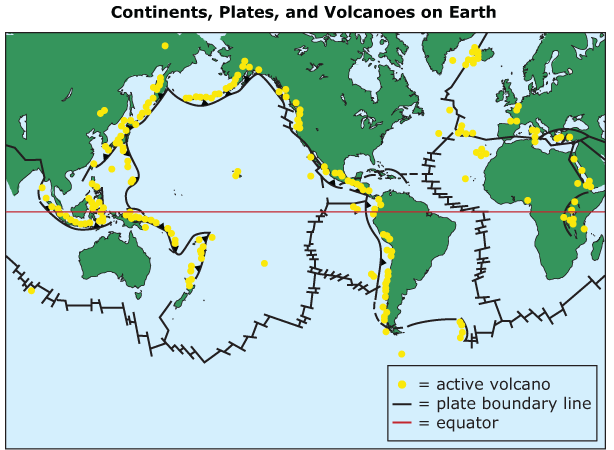 Source: United States Geological Survey
Source: United States Geological Survey
Volcanoes are typically found near the black lines on the graph, which represent plate boundary lines.
A typical energy pyramid is depicted in the diagram. Which of the following statements accurately describes the flow of energy via this pyramid?
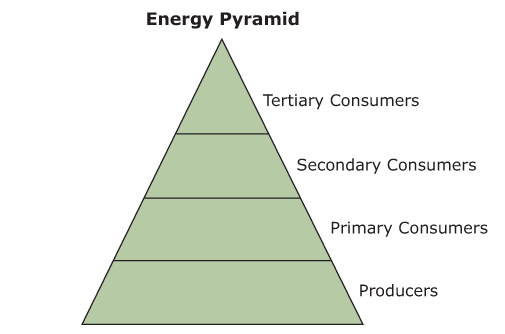
The diagram's shape and structure indicate that energy is transported directly from one level to the next, beginning at the bottom of the pyramid. As a result of their proximity on the pyramid, energy is transferred directly from primary to secondary consumers.
A scientist collects data on the solubility of various salts at various temperatures. The graph depicts the outcomes. Which conclusion is supported by the graph's data?
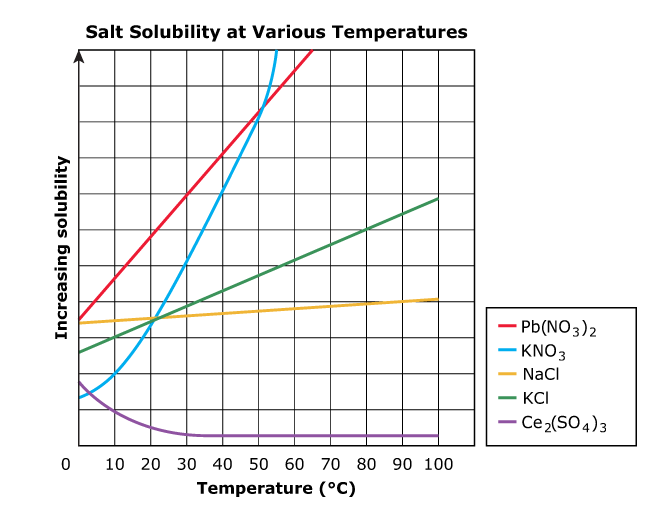
As the temperature rises, the rate of change in KNO₃ solubility changes. The KNO₃ line graph shows that solubility does not increase at a steady rate as temperature rises.
Newton's second law of motion states that an object's acceleration is proportional to its mass and the amount of force applied to it. The table displays data from a study of Newton's second law. Which of the following statements best represents the pattern established in the data provided in the chart?
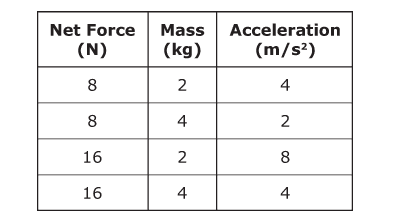
When the object's mass is held constant in the first two rows of the table, increasing the mass reduces the acceleration by two times. You may have also observed that the identical pattern appears in the table's last two rows.
The diagram depicts a meiosis-related event. What is the outcome of this occurrence?
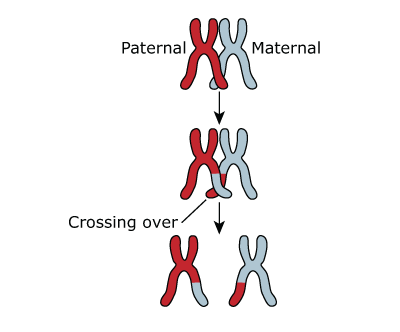
Crossing over during meiosis results in two chromosomes that are genetic mixtures of both maternal (mother) and paternal (father) chromosomes.
Advertisement
For four samples, researchers collected data to evaluate volumetric bone density. What is the average bone density for the submitted data samples?
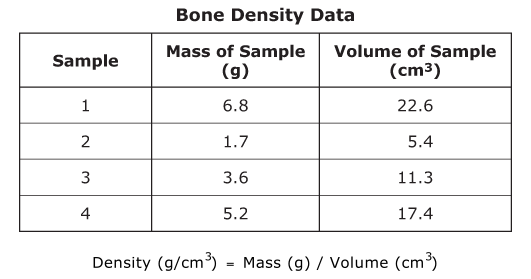
You divided the mass by the volume for each of the four samples, then averaged the densities. Finally, you rounded the answer to two significant digits appropriately.
According to the table, which of the following animals is a tertiary consumer?
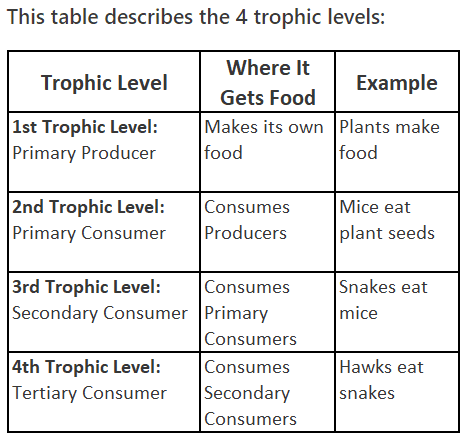
Tertiary consumers get their food from secondary consumers, based on the table. The apex predators in the food chain are tertiary consumers, such as the great white shark. Another method for resolving this issue is through the process of elimination. Deer devour grass and other foliage, therefore they are primary consumers; anteaters consume ants, which consume minute particles of vegetation, so they are secondary consumers; and squirrels consume nuts, so they are primary consumers. As a result, the only logical answer is the great white shark.
How do primary producers obtain energy?
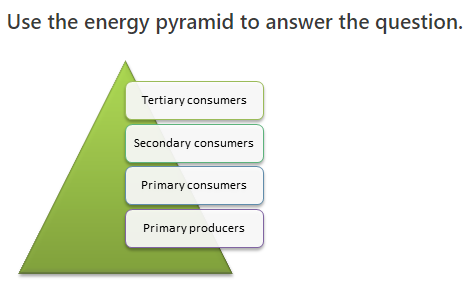
Plants, for instance, employ photosynthesis to convert light energy into ATP, which may then be used as chemical energy. Primary, secondary, and tertiary consumers must rely on energy produced by organisms in the pyramid underneath them; they use glycolysis, the citric acid cycle, and oxidative phosphorylation to produce ATP from the glucose molecules they ingest.
The Grand Canyon, located in Arizona's Grand Canyon National Park, was formed by the Colorado River around 5 million years ago. The Grand Canyon is 277 miles long, up to 18 miles broad, and over a mile deep. What interaction of Earth's systems most likely resulted in the formation of this landmark?
The Grand Canyon is a great example of erosion caused by the passage of water. Wind abrasion would be capable of eroding weak structures, such as those composed of sandstone, but would have minimal impact on compacted soil. Landslides have an impact on moderate, rainy regions but would not occur in Arizona's desert. Tectonic fissures, or earthquakes, can form sinkholes and other openings in solid soil, but they cannot form a canyon the size of the Grand Canyon.
The following two hypotheses have been supported by multiple studies: I. Increasing the temperature of Solvent A causes all dissolvable solutes to dissolve more quickly. II. Substance A dissolves in Solvent A but not Substance B. Which of the following is most likely to be true, given these two hypotheses?
At higher temperatures, Substance A dissolves faster in Solvent A. This assertion is true because the two hypotheses are transitive. Substance B will not dissolve in Solvent A, regardless of temperature, as stated in hypothesis II. Because Substance A dissolves in Solvent A, the sole option is that Substance A dissolves faster in Solvent A at higher temperatures, which is supported by Hypothesis I.
When a person reaches out and touches a hot pan, the __________ system is triggered, and the __________ system is activated to take the hand away.
The neurological system sends a signal to the muscular system, which causes the hand to move away. The nervous system is in charge of communication between the many body systems. In the scenario given, the nervous system first activates and sends a signal to the muscles to move in order to protect the body. The muscular system is in charge of movement, the skeletal system is in charge of bodily structure, and the endocrine system is in charge of hormone regulation.